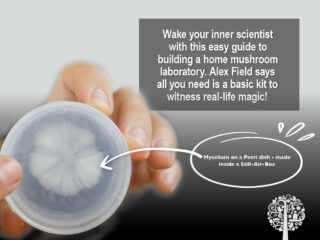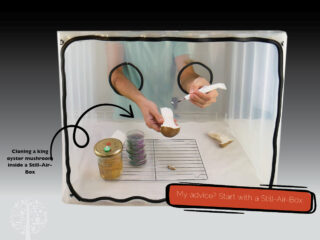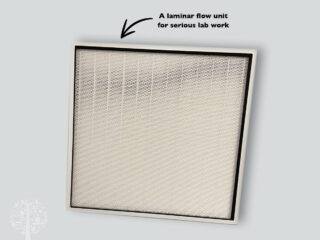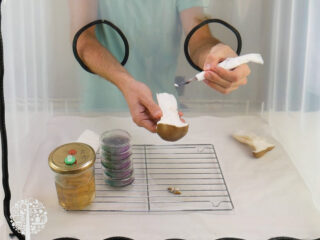How To Build A Home Mushroom Laboratory
Working with mushroom mycelium is where sci-fi becomes a reality—cloning mutant mushrooms, growing spores in fractal patterns on Petri dishes, and training mushroom genetics for new varieties that have never existed. This is real-life magic, and you can do it all with a basic kit inside your home.
Whether you’re looking to breed the perfect strain of mushroom – or get your grow on without contamination – Rule Number One for mycology is to have a clean workplace. Here are two options for doing sterile lab work at home.


The Bathroom Floor Method
With up to 10,000 spores in a cubic metre of air, many people grow more mould than mushrooms. This low-tech approach uses water vapour to ground particles in the air. This can create a clean enough environment for inoculation and other jobs that don’t involve lots of open-air exposure.
- Clean your bathroom well.
- Have (or run) a hot shower with the window and door closed. Let the room get steamy.
- Turn off the shower, leave the room, and shut the door.
- Come back in an hour later when the water vapour has landed. Ensure your hands and arms are clean and move slowly to avoid unnecessary air currents.
- Now you can do your work!


The Still-Air-Box Method
This breathtakingly simple method allows for some proper geeking out. By obstructing airflow, particles inside the box are grounded, creating a sterile space. I have done open-air work with Petri dishes, clones, and spores inside one of these with a very high success rate.
Note: Avoid the temptation to stick gloves on the inside of your box – unless your unit is airtight. Moving in and out with gloves on can create air suction elsewhere and create a storm inside your box. It’s much better to make holes slightly bigger than your arms, as in this method.
- Take a plastic box that’s big enough to move your arms around and contain whatever you will be working with. Around 110 litres is a good size. You will need a taller tub if you’ll be working with big bags of grain or substrate.
- Take the lid off and turn the tub upside down. Put it on your table or wherever you will be doing your work, and mark with a pen where your arms will comfortably fit.
- Take a 4-inch hole saw (bigger if you’ve got wide arms) and gently drill arm holes in the side of your tub. Go slow here and put your drill on reverse to prevent the tub from cracking. If you don’t have access to a hole saw, you can use a very hot, wide tin can to melt holes (not pleasant or advised!).
- Clean off any loose bits of plastic, and you’re good to go!
When I do lab work with a still air box, I lay a shower curtain on my work surface, spraying and wiping everything with 70% isopropyl alcohol (including my clean arms and hands). I like to put an over-grill tray on the tabletop so that I’m not disturbing any grounded particles when I pick things up and put them down. Then, I put my upturned Still Air Box on top, clean my arms and hands well, and get to work!


Get a Laminar Flow Unit
It took me years of serious mycology to get one of these. They’re not cheap and take up a lot of space, but they’re excellent for the hardcore mycologist.
Laminar flow units contain high-quality HEPA filters and push a steady stream of clean air over your work surface. This means guaranteed sterility for open-air lab work. I can leave Petri dishes and test tubes open in front of mine, and if my kit (and my hands) are clean, no baddies are getting close.
Stuck for Choice?
My advice? Start with a Still-Air-Box. They’re easy and cheap to make and incredibly effective. If you catch the bug and decide to go pro one day, you can consider an upgrade.
Check out Alex’s online course, theHome Mushroom Laboratory, for more on how to use your lab






